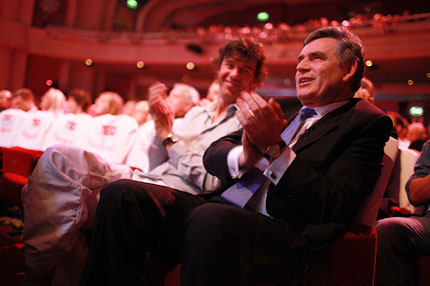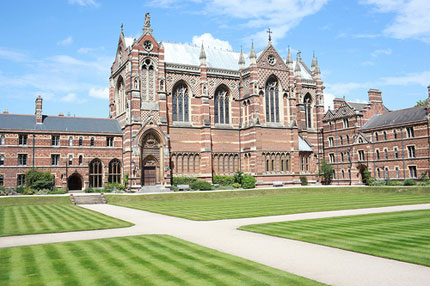
Odd TED fellows: TEDGlobal speakers Stefan Sagmeister and Gordon Brown. Photo: TED/Robert Leslie
At some point while an 18-year-old musical prodigy was performing on the euphonium, I stepped away from the TEDGlobal conference for a cup of tea. (TED, let me add, is the conference on Technology, Entertainment and Design, which has long surmounted all of those categories though it still sounds like it’s named after your pharmacist.) When I returned to the event 20 minutes later, I found a dark-haired man with a Scottish accent telling an anecdote about Amy Winehouse appearing at a benefit concert in honor of Nelson Mandela and declaring that she and Mandela had a lot in common: Her husband, too, Winehouse reportedly said, had spent a long time in prison.
If you’ve been keeping up with TED Talks, the videoed lectures offered for free in languages that include Macedonian and Urdu, you know what took me several minutes to grasp: that the amusing Scottish guy was Britain’s prime minister, Gordon Brown, making an unpublicized appearance. Between jokes (unexpected ones, given his reputation for stodginess), Brown called for the support of global institutions to solve global problems such as climate change, security and financial collapse, a federation that “ensures that the prosperity of the world is indivisible.”
This revelation was what Chris Anderson, the conference’s curator, would describe as a TED moment. Now, normally I would chafe under such vague and cloistered labels. But I couldn’t brush off the awe. It’s one thing when Al Gore takes the stage at TED, as he did last February in Long Beach, California, to stump for the environment among a crowd of concerned and wealthy Americans who resent his filched presidency. It’s another to bring on a sitting world leader who has any number of stages and audiences to choose from. Hell, if Brown wants to talk to Obama about global institutional sovereignty, all he has to do is pick up the phone. He doesn’t have to talk to us.
I say us, but I mean not just the people who make up the immediate audience, 700 at this latest event, but the millions who visit online after the live show is over. TED, as a result of one of those counterintuitive gestures that are reshaping the media business, exploded in prominence and influence once it began giving away its content. Three hundred thousand TED Talks are viewed each day. The franchise has expanded not just overseas in summer but also to exotic parts in the fall; TEDIndia is planned for November, the third happening of 2009.
That’s three, if you count the elaborately produced conferences that interleave speeches with musical performances and top off the days with Chardonnay-soaked parties. But TED has also loaned its name and quirky format (18-minute speeches, mix of talks and entertainment — what the Times of London recently described as “the intellectual equivalent of a foie gras production line”) to self-initiated one-day TEDx conferences throughout the world; more than 200 are in the works, from Detroit to Buenos Aires to Temanggung, Indonesia. And it has started a TED Fellows program that brings international social entrepreneurs, aid workers, scientists and artists to the main events, some of whom take the stage themselves at TED University, a mini pre-conference featuring TED audience members.
In these locavore, curses-on-Starbucks times, one may wonder whether quality will be eroded by such aggressive expansion, but TED is better than ever. I’ve attended these conferences since 2003 and found in TEDGlobal the vaudeville-like format taken to its summit with an admirably high caliber of presentations. (The high caliber of TED speakers goes without saying, but some have been known to flounder and die under the ruthless ticking of the clock.) Thus a pro like the comedic actor and author Stephen Fry, dissecting the phenotypes of Oxford and Cambridge alumni, found his match in Cary Fowler, an agricultural conservationist who installed a seed bank in a mountain in Svalbard, Norway, halfway between the Norwegian mainland and the North Pole. A decorous man with a Tennessee twang, Fowler described stashing in that cold place 425,000 samples of unique crop varieties to stave off the inevitable famine that global warming will bring if drought-resistant species die out. No amount of smooth erudition could compete with that, and Fry, for all his charm, came off as a little wobbly.
TED’s themes are historically ribbons draped around the eclectic contents to keep them from slipping out of the pile, and I had no great expectations for TEDGlobal’s topic, “The Substance of Things Not Seen.” As it happened, it was a fine topic, loose enough to wrap around the philosopher Alain de Botton, who talked about the slippery nature of success (“We have to make sure we’re truly the authors of our ambitions; it’s bad not getting what we want, but worse to get what you thought you wanted and realize it’s not what you wanted all along”). Loose enough even to wrap around Elaine Morgan, a scientist who believes our primate ancestors were creatures of the sea, which accounts for everything from our baldness (relative to chimps) to our habit of swimming in utero. In Morgan’s case, the substance of things not seen has been any sign of institutional respect for her “aquatic ape” theory, which many find crackpot. That was good enough for me.
Even better were presentations solicited with a view to the topic that might never have otherwise seen the light of TED: The astronomer Andrea Ghez positing the existence of a black hole at the center of our galaxy — and every other galaxy in the universe. The photographer Taryn Simon presenting images of off-limit facilities — a place where white tigers are bred, the rooms at JFK airport where contraband is stashed — then proceeding even deeper into the heart of darkness with a portrait series of men who were imprisoned for crimes they didn’t commit. The conductor Itay Talgram using slow-motion film clips to parse the gestures and expressions of fellow maestros such as Leonard Bernstein and Herbert von Karajan. The journalist Misha Glenny discoursing on McMafia, or the expansion of organized crime, which accounts, he claims, for 15 percent of the global GDP. The micro-sculptor Willard Wigan exhibiting a half-timber house with landscaping that he built on the head of a pin, its roof made from a fiber from his sister’s old Teddy bear. “Sometimes,” he admitted, “I inhale my own work.”

And these were the budget accommodations: Oxford's Keble College housed many of the attendees. Photo: TED/Robert Leslie
TEDGlobal’s precincts added a great deal to its charm. Oxford, with its medieval quadrangled buildings, Victorian heaps and contemporary hullabaloo is all about eclecticism. It’s no accident that Oxford is the setting for His Dark Materials, novelist Philip Pullman’s trilogy about universes that spill into one another through rents in a cosmic fabric. TED’s organizers have mastered the pace and flow of their program, while engendering the crazy collisions of ideas that keep the audience both dazed and energized. An unlikely state of affairs, it’s true. But if you've seen the Incredible Hulk installed in the eye of a needle, you can believe anything.
